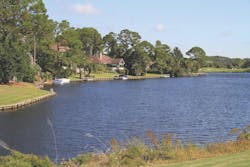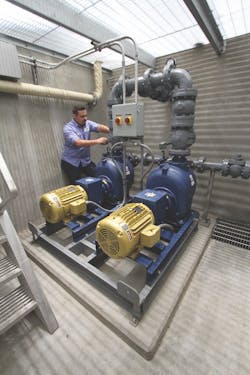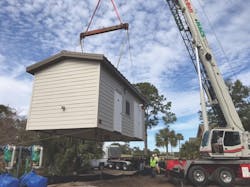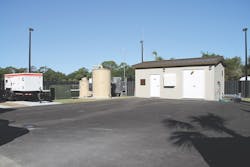Vacuum Sewer Revamp
About the author:
Mike Allen is the general manager for Broad Creek Public Service District on Hilton Head Island, South Carolina. Allen can be reached at [email protected].
Hilton Head Island is well known as a residential and recreational paradise. Only 70 square miles in size, it is home to several high-end developments, resorts, restaurants, shopping areas and more than 30 golf courses that attract clientele from all over the world. The beaches are nice, the scenery is beautiful and the weather is usually pleasant. It is a jewel on the South Carolina coast, being voted “number one island in the continental U.S.” by Travel + Leisure magazine four years in a row.
Approximately 40% of the island is covered with canals, creeks and marshland, and there are 12 miles of beautiful public beachfront overlooking the Atlantic Ocean. The topography is flat, the groundwater is high and the soil is sandy, typical for islands in this region. Also, the population density is seasonally high as about 2.7 million visitors come to the island annually.
These are conditions that often lead to groundwater pollution, especially in areas where there is insufficient wastewater infrastructure.
However, the waters in and around Hilton Head remain clean and the aquatic life is healthy. Likewise, the local economy is robust and thriving with continued development. All of this is because developers almost 50 years ago invested in modern wastewater collection and treatment. The return on that investment continues today.
The Evolution & Advancements in Vacuum Sewer Design
Broad Creek Public Service District (BCPSD), which is one of three public service districts on the island, recently completed the renovation of a sewer it first installed in the early 1970s. Vacuum sewers were not common at that time because the technology was relatively new and unproven. Now, almost five decades later, vacuum sewers have shown to be effective as a collection system that can prevent pollution.
The original system installed in 1973 lacked many of the features of today’s modern vacuum sewers. Built by a company new to the vacuum sewer business, the system had deficiencies that were revealed over time. The collection lines were too small for the number of connections; the characteristic “saw tooth” profile—a key feature of today’s vacuum collection lines—did not exist at the time; and the equipment in the vacuum station lacked other modern features common in today’s technology.
BCPSD has worked with Airvac, a vacuum sewer supplier, and local contractor Taylor Construction over the past several years to upgrade and improve the collection lines and valve pits in the Hilton Head vacuum collection system. The size of the collection lines was increased from 4 to 6 inches, and the vacuum mains were modified in places to incorporate the saw-tooth profile, which is essential for maintaining vacuum pressure. These changes alone enhanced performance significantly.
Meanwhile, Hilton Head also solved a problem with the vacuum interface valves and valve pits. Vacuum interface valves are mechanisms that control sewer discharge from individual homes into the collection line. They had previously been installed just below ground level, but because of the high water table on Hilton Head, the mechanisms were often under water, creating failures at the individual tanks. The new design raised them approximately 1 foot above ground level in a protective enclosure that resembles a stone, so it blends into the natural environment. The valves now function better and are easier to access.
A Fully Packaged Solution
In recent years, Airvac developed a new option for vacuum stations, which is the heart of any vacuum sewer system. The PacVac is a pre-assembled and compact vacuum station that can be delivered, installed and brought online within a matter of weeks.
Rather than designing and building a new vacuum station from scratch, Airvac contracted with EFI-Solutions in Centralia, Illinois, to build stations that can be delivered and hoisted into place. Airvac provides the equipment: the vacuum pumps, sewage pumps, tanks, controls and so forth. The equipment is installed onto a skid at the factory and tested, then the package is delivered to the site to a prepared foundation.
BCPSD used BRW Construction Group as its general contractor to build its foundation, conduct the site work and connect the equipment and controls. The new station equipment and building were lowered onto the foundation and connected to the existing sewer collection line.
In this case, the new station was up and running in a matter of weeks. Building a new vacuum station from the ground up would have required at least three months and created significant interruptions for residents. Hilton Head did not have that kind of time as its old vacuum station was at the point of failure.
The site has ample parking, yet the station’s footprint covers only 300 square feet, which is compact as far as vacuum stations are concerned. Telemetry monitors the vacuum station, delivering information to the crew. Workers can make adjustments via wireless tablet. Operating the entire vacuum system, which serves almost 1,000 residents efficiently and effectively.
Odor also was an issue that needed to be addressed, and engineering firm Hussey Gay Bell provided an idea that reduced odor. There have been no odor complaints since the system went online.
Environmental Protection
Many seaside towns have similar physical characteristics to Hilton Head. A lot of them started as tiny resort communities with small vacation homes on large parcels. Many residents relied on septic systems for wastewater removal and treatment. Those systems worked fine when the population density was low, but as these communities grew—some rapidly—the number of septic systems in close proximity overwhelmed the groundwater with nutrients. The runoff into local canals, lagoons and coastal waters generated excessive algae growth that became destructive to marine life, causing aquatic plants, fish and mammals to suffer.
Modern wastewater collection and treatment helps solve this problem. Vacuum sewers are especially environmentally friendly, as vacuum collection lines do not overflow like gravity lines. If vacuum lines are broken they can be isolated and fixed. Vacuum lines are typically buried shallow, often about 4 to 6 feet deep, which makes excavation and repair easy and fast. Vacuum lines also prevent infiltration of storm water and sediment, which helps reduce wastewater treatment costs.
Hilton Head staff appreciates the convenience of its new vacuum system. Vacuum sewers are “closed systems,” so they rarely come in contact with or even see raw sewage, meaning the vacuum station is streamlined and clean. Additionally, all system functions are easily monitored at the control panel or on tablets via SCADA.
Airvac has been a partner with BCPSD helping it through every stage of the system rehab. It was available for technical support when needed, which BCPSD administration listed high on its list of appreciation.
BCPSD leadership is confident the revamped vacuum sewer system will be serving the community for many decades to come, protecting Hilton Head Island’s environment—its most valuable resource—by keeping it clean, safe and healthy while providing reliable sewer service for customers.





